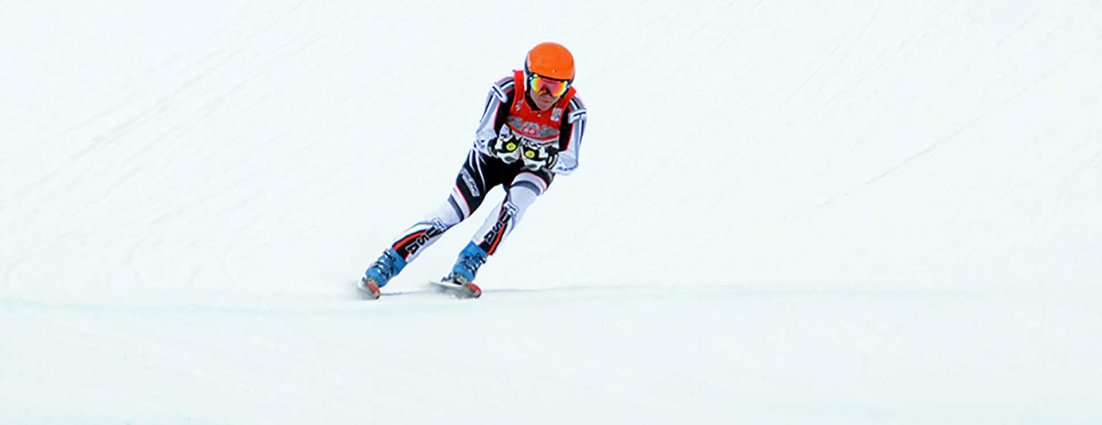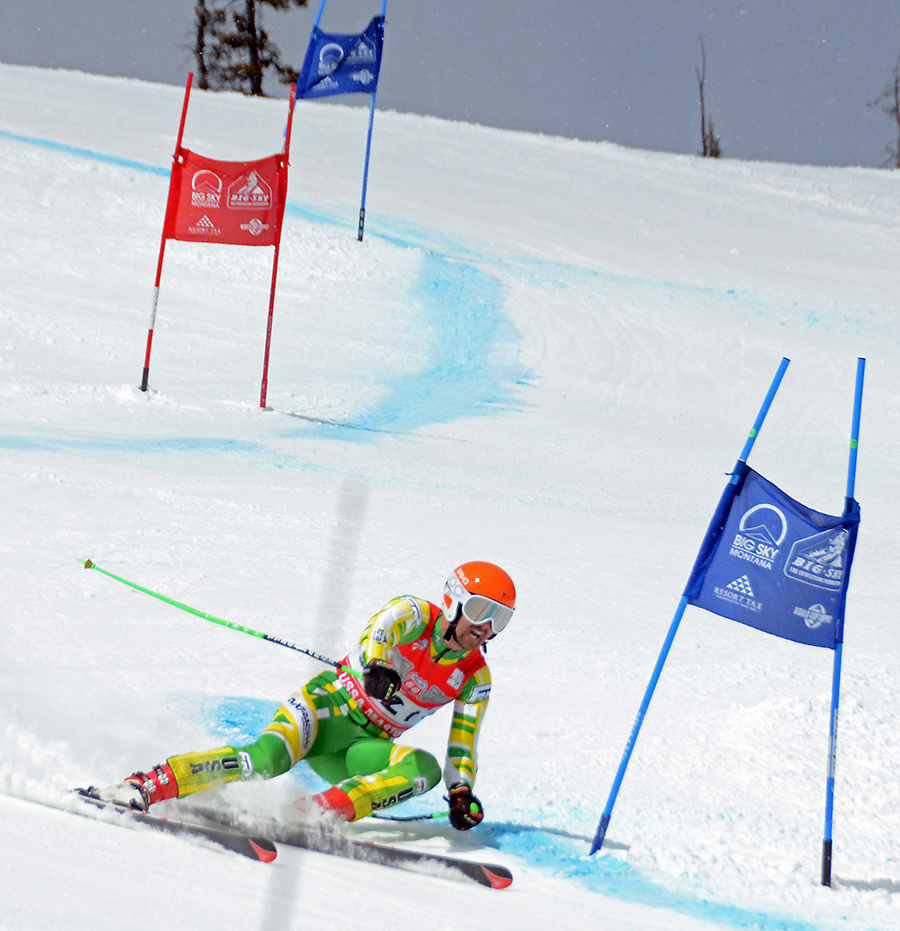Going Big at The Big Event
02.23.2017 | Lisa Densmore Ballard

What makes one racer top the podium again and again — and another accomplished athlete suddenly choke?
I saw it happen firsthand at Big Sky, MT, at the Phillips 66 U.S/ Masters Championships in mid-March. It’s the nature of any top-level competition. We all know that winning at a big event takes desire, physical preparation and on-snow training and mental focus. But the strategies throughout this article can help increase the odds of earning a medal.
I am a Masters racer myself. A lot of the events that I reference in this article are Masters races along with Masters athletes. If you are unfamiliar with the format of Masters racing, you can visit their website, here, to become better acquainted.
1. Treat the Big Event like any other race.
Easier said than done. After all, it’s the big one, which probably involves more travel, more hype, more competition and more social opportunities. Adding to the challenge is the fact that it might be your first time racing at the host mountain. Despite these factors, if you can keep things “normal,” your odds of performing better will be higher.
“I always try to do my best and enjoy the moment no matter which race it is,” says Pierre Jeangirard, a well-qualified masters racer. “I like the pressure of big events because of the competition, but it’s not different than any other race except that the results are more rewarding.”
Rocky Mountain master Lauren Beckos managed to channel the higher energy of Masters Nationals into wins in women’s “Class 2” in every event at Big Sky. “I tell myself the same thing in every starting gate — have as much fun as I can,’” she says. “But at Nationals, there’s an extra feeling of excitement to leave it all out there. You have to wait a whole year for another shot to race against many of your competitors from other divisions.”

2. Ski Smarter.
With more racers on the roster and more depth in the field, many skiers approach every run with an “all or nothing” attitude. But sometimes, an “almost all” strategy is better.
“I always try to do my best because every class competition requires full-on racing,” says Nick Hudson of Rocky Mountain, a member of the 2016 Masters National Team who nabbed a bronze in the downhill and GS and silver in the slalom and combined in men’s Class 10 at Big Sky. “You need to take risks to be faster than a competitor, but you also need to consider where you stand in the combined. Ski the way you know how. You won’t re-invent yourself on race day.”
3. Rest Up.
“I get more sleep before I go to a big event,” says Hudson. “I don’t overdo it after a race, either, if there are more race days. At Big Sky, I wasn’t skiing on Lone Peak, though I would have liked to.”
Rocky Mountain masters star Jennifer Kaufman says she likes to freeski, but keeps it reasonable. “I get a huge rush from major events, but I also try to make sure I am not wearing myself out,” she says. “I may be out freeskiing, but probably not doing nonstop mogul runs. If I am feeling a bit tired, I’ll spin or do a light run to get my legs going.”
4. Loosen Up and Stay Hydrated.
To stay sharp and energized at a Big Event, Beckos brings plenty of water and food. Far West racer Linda Crowell finds a gym for light workouts and stretches a lot. And Karen Kilian, a member of the 2016 Masters National Team from the Pacific Northwest, rides a stationary bike or jogs.
“I learned at a race camp that after a day of racing, it’s good to do something active for 20 minutes,” says Kilian. “It helps get rid of lactic acid in the muscles. I also drink plenty of fluids. Altitude, dry air and working hard on the hill can lead to dehydration, which will affect your ability to ski well.”
5. Focus mentally.
Sure, but how, especially when a big event is usually several days long? For example, the NASTAR Nationals includes a GS and slalom, often with qualifications for the Race of Champions, and then of course, the team races.
“I can’t change anything about my skiing technique on race day,” says Kaufman, who skipped the Masters Nationals this year to race another big event: the Criterium in the Czech Republic. “I try not to worry about what I did or didn’t do earlier in the season. I’m in the moment and ski hard when the time comes. I take each race one day at a time.”
The Masters Nationals at Big Sky was an even longer marathon — three days for the downhill, then three more days for the super G, GS and slalom. Rocky Mountain’s Phillips Armstrong, who won gold in the super G and combined plus three silvers in downhill, GS and slalom in men’s Class 2, follows a similar strategy to Kaufman. “I try to think about the week in small blocks,” he says. “Thinking of all the runs at once puts too much mental pressure on me.”
Easterner Pepi Neubauer, who won the downhill, super G and GS in men’s Class 10 and who’s on track to win the FIS Masters Cup in his age group this winter, definitely finds another gear for Big Events. “I do get myself pumped up,” he says. “I put myself in a special frame of mind until the races are over. It helps to stay hydrated, eat good food — carbs and protein — get a good night’s sleep and not party too much.”
6. Arrive Early.
If it’s a place where he hasn’t competed before, Neubauer makes a point of arriving at least a day early to check out the race venue. Hudson does, too.
“I get familiar with changing fall lines, terrain, blind spots and snow conditions before the race,” says Hudson. “It helps a lot.”
“I review the last race email sent out to make sure I didn’t miss anything,” says Beckos. “I also look to see where the parking and race trail is on the resort’s website. I always aim to be there when registration opens or inspection opens on a new hill. The extra time keeps me on schedule and insures a more enjoyable, relaxing day.”
“One of my stress points is not being familiar with how to get to the start or the course,” says Kaufman. “If I’m not familiar with the mountain, I try to get everything figured out in advance, such as where I am staying and how to get to the course from there, so on race day I can calmly get to the start on time and get myself warmed up and ready to race. I mentally rehearse how my day will go. If I am uncertain about something, I ask about it.”
7. Have Fun!
This is my most important factor when it comes to going big at a Big Event. When I’m enjoying myself, I’m more relaxed and feel looser and stronger on my skis.
“Look around at the smiling faces of other racers and feel the energy and support,” says Beckos. “We’re all there to challenge ourselves and each other.”
Her husband, John, who won the slalom and super G in men’s Class 2 at Big Sky, is another enjoy-the-moment racer. “For us younger, non-retired racers, win or lose, we have to go to work afterward, so I enjoy the camaraderie,” he says. “Not everyone gets to ski race where you can try to go as fast as you can!”
And if you don’t ski well, it’s not the end of the world. “I’m there to have fun and if I do well, that’s great,” say Jeangirard. “If I don’t, life goes on. I do get disappointed if I make mistakes, but if I ski well and get beat then I have to do better next time.”